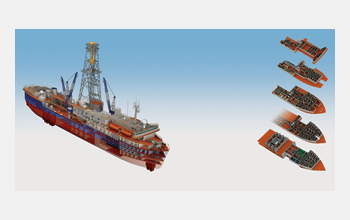Multimedia Gallery
3D illustration showing plans for JOIDES Resolutiion's overhaul
A 3D illustration showing decks and lab layout on planned modernization of ocean drillship JOIDES Resolution.
The top deck is called the bridge deck (top right). The ship's dynamic positioning system is now integrated into the bridge. Technical support, science and operations offices for the Integrated Ocean Drilling Program (IODP) and a science planning area are now located on the bridge deck.
The second deck down is called the core deck. From the receiving platform on this deck, cores that have been drilled from the ocean floor are taken through a series of scientific analyses. Downhole measurements, microscopy, paleontology, core description, petrophysics, stratigraphic correlation and paleomagnetism labs are on the core deck.
The third deck level is called the fo'c's'le deck (pronounced forecastle), which now includes the following facilities: chemistry, microbiology, sample preparation, thin-section and X-ray lab; imaging office; publications office; videoconference-enabled conference room for an entire science party; and a hospital.
The fourth deck down is called the main deck, where the galley, mess hall, food storage areas, laundry room, card room and the crew changing room are located.
The fifth deck down is called the forward 'tween deck, which houses the ship's recreation areas and features a lounge for social gatherings, computers for casual Internet use, a coffee and snack bar, public telephone, movie room with new entertainment systems and an air-conditioned gym.
The JOIDES is a dynamically positioned drillship and floating lab that can drill down more than 2,000 meters into the sea floor in water as deep as 7,000 meters. On-board the JOIDES, scientists from all over the world lead expeditions aimed at the deep biosphere and the sub-seafloor ocean; environmental change, processes and effects; and solid earth cycles and geodynamics. These are the principal science themes for the IODP, the international endeavor for which the new and improved JOIDES will primarily work.
The ship's overhaul has resulted in a new U.S. drilling vessel for IODP. Lab space has been increased by 34 percent and is designed for greater efficiency in handling cores. There are 16 additional berths and all staterooms are double occupancy. Drilling capabilities and ship stability have been enhanced.
The National Science Foundation is one of several IODP funding agencies. To learn more about the program, visit the IODP website. (Date of Image: 2007)
Credit: Integrated Ocean Drilling Program; Illustration by Charles Floyd
Images and other media in the National Science Foundation Multimedia Gallery are available for use in print and electronic material by NSF employees, members of the media, university staff, teachers and the general public. All media in the gallery are intended for personal, educational and nonprofit/non-commercial use only.
Images credited to the National Science Foundation, a federal agency, are in the public domain. The images were created by employees of the United States Government as part of their official duties or prepared by contractors as "works for hire" for NSF. You may freely use NSF-credited images and, at your discretion, credit NSF with a "Courtesy: National Science Foundation" notation.
Additional information about general usage can be found in Conditions.
Also Available:
Download the high-resolution TIF version of the image. (106.4 MB)
Use your mouse to right-click (Mac users may need to Ctrl-click) the link above and choose the option that will save the file or target to your computer.



 All images in this series
All images in this series